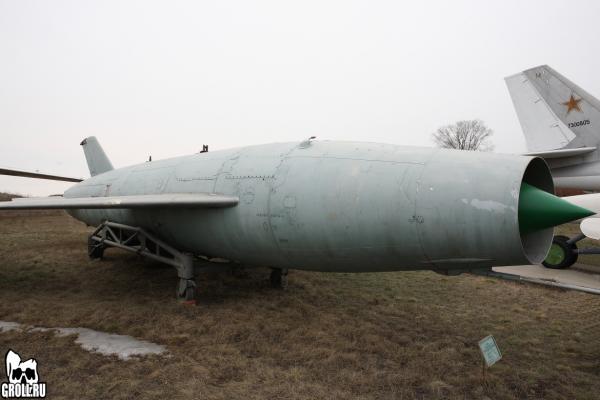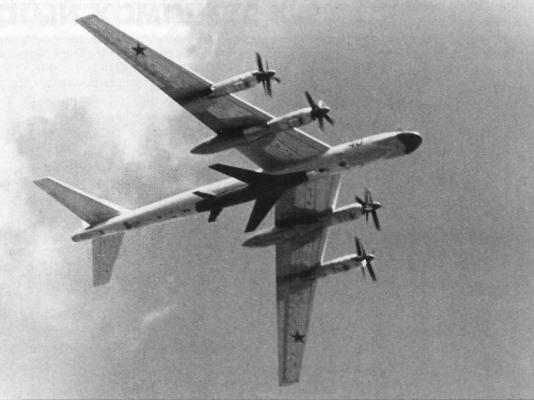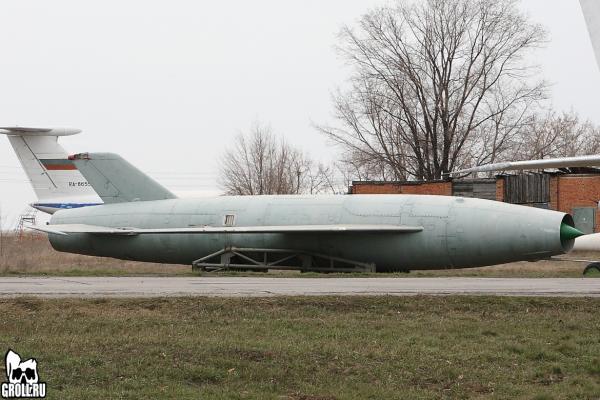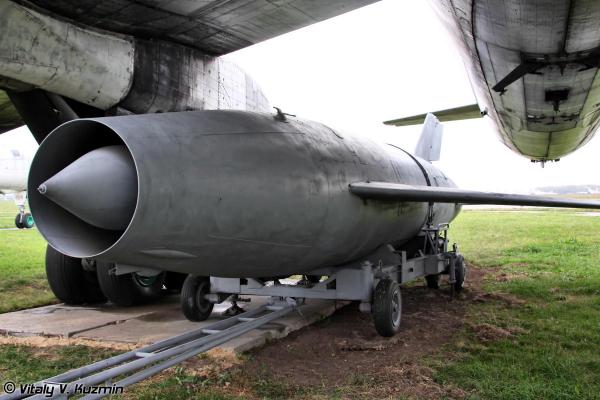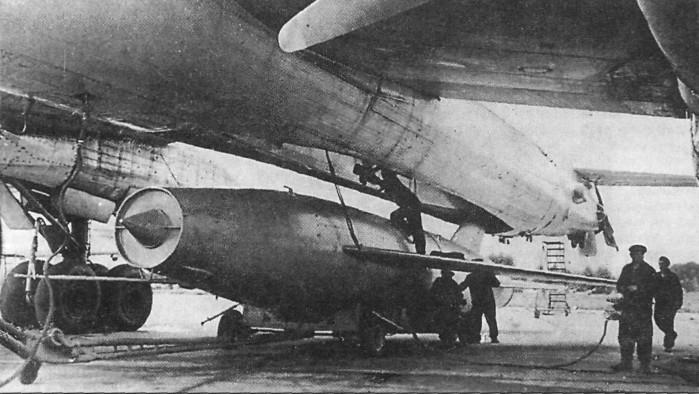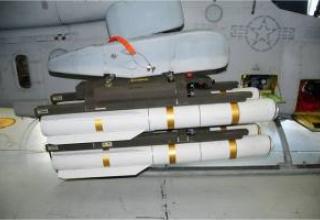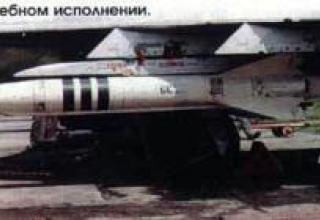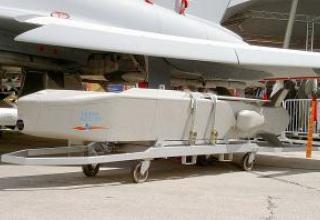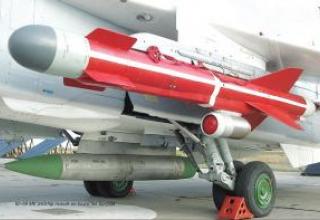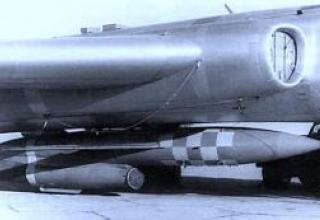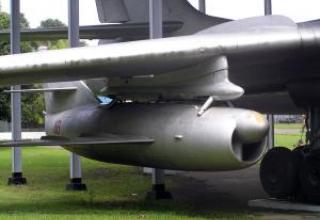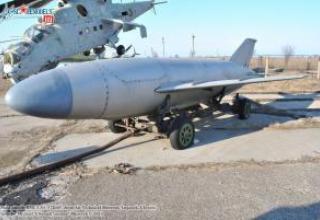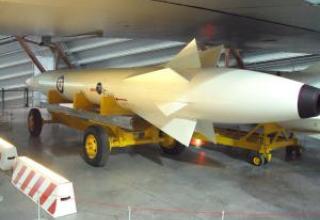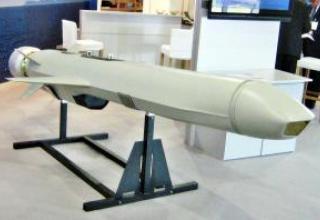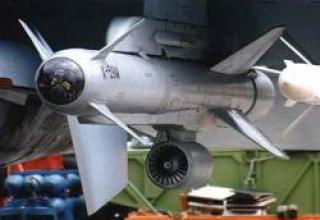March 11, 1954 was issued the Decree of the Council of Ministers of the USSR on the creation of an aviation system of missile weapons K-20, which Tupolev Design Bureau-156, appointed by the leading executor, was ordered to develop a carrier aircraft Tu-95K on the basis of Tu-95MA bomber (carrier of nuclear warheads). The same document appointed organizations that develop components of the complex. In their capacity were enterprises that already had experience working together on anti-ship missile "Comet". The K-20 guidance system was entrusted with the development of Design Bureau-1 of the Ministry of Medium Machine Building under the leadership of V.M.Shabanov, the X-20 projectile aircraft - Design Bureau-155 A.I.Mikoyan (Chief Designer M.I.Gurevich).
Requirements for the system stipulated the possibility of hitting large strategic targets at a range of about 600 km with the flight of the carrier at altitudes up to 12-13 km. The X-20 speed had to be supersonic, not less than 1700-2000 km/hour, which was ahead of the existing fighters. The size of the missile was determined by the use of the agreed BC - nuclear charge, whose mass with the necessary systems was about 4000 kg.
Acting with reasonable conservatism and based on the experience of "Kometa", the engineers of OKB-155 chose a reliable TRD. The use of the turbojet propulsion system simplified the issues of power supply to the rocket - the TRD drive box provided operation of the electric generator and hydraulic system pumps. Taking into account the requirements on the speed and mass dimensional characteristics of the rocket, the thrust of about 10-11 tons was required. Suitable and the only engine in terms of thrust and dimensions was AL-7F - the newest TRD, which has just passed the test on the fighter I-7U. However, this power unit weighed 1700 kg, and flying on supersonic required the use of afterburning mode with the corresponding fuel consumption, the stock of which had to be about 4000 kg to achieve the calculated range.
In the development of the X-20 used the experience of Mikoyan design and construction of supersonic fighters (as in the design of "Comet" reflected many solutions of the MiG-15). The airplane shell was built according to an aircraft scheme with a frontal air intake, constructively borrowing many features of the same I-7U.
Only the general layout, wing geometry with a 55° sweep and supersonic profile were borrowed from the fighter. At the same time, features of the X-20 as a single-mode aircraft, not intended for maneuvering and low speeds at takeoff and landing, allowed to reduce the area of the wing and its chord, giving up flaps and brake plates. In view of the lack of takeoff and landing modes, the specific load on the wing of the projectile was brought to 470 kg/m2 (one and a half times greater than that of MiG-19), but on demand for range this parameter was chosen significantly less than that of the "near" and high-speed K-10, where it was 640 kg/m2. To avoid reversal of ailerons encountered on supersonic aircraft, especially with low rigidity of the lightweight structure of the wing of the missile, ailerons were placed closer to the root of the wing (good this did not interfere with the missing flap), halved their deflection angles with a simultaneous increase in their area to maintain sufficient control on the roll.
Initially, in the size of the tail fins were observed normal aircraft proportions, but due to moderate requirements for maneuverability (in the main modes of flight the task was to maintain the stability of the rocket) in the final version of the plumage significantly reduced, and the relative area of horizontal plumage was only 16% of the wing area, and vertical - 11.2% (against the conventional aircraft 20-25%). The keel thus shifted unusually close to the center of gravity of the rocket - already for layout reasons, its suspension under the carrier, where its usual location prevented the fuselage tanks. For stabilization and control in transient modes were sufficient small angles of deflection of the rudder altitude and one-piece stabilizer (the need for its use was revealed during tests of the MiG-19).
The scheme with the frontal air intake did not suit the layout of the missile in the best way, complicating the construction with long air channels that "eaten" internal volumes and caused aerodynamic losses. However, it provided the smallest middles, in addition, for supersonic speeds, such an air intake was then sufficiently worked out and did not promise problems. In general, the scheme and design of the X-20 became a practical compromise required and available to the designers.
To the full extent it concerned the guidance system as well - the classical radio command control was not suitable due to the given over-the-horizon range - the signal at such a distance was weakened, the method was unreliable due to failure of guidance in case of failure of the command line and was vulnerable to interference. In addition, it was difficult to control the missile's flight to the target. Radar guidance using the missile's CNS, active or illuminated by the target carrier, at such ranges was also ineffective, mainly due to insufficient radar visibility of targets - many strategic objects, however large, did not differ in radio contrast in the background, not to mention that the given range was outside the radio horizon.
The main combat tasks of long-range aviation were the defeat of the enemy's nuclear missile groups, its military-industrial and energy facilities, violation of state and military administration, defeat of operational and strategic reserves and transportation. The respective targets - military bases, airfields, warehouses and control points - were not only low-contrast on the ground (except for transport hubs and seaports), but they were usually camouflaged, which made radar, thermal and other similar systems of guidance of means of destruction useless. However, such objects were large and georeferenced, and their location was a point of reference for a combat mission, allowing them to be described as "targets with predetermined coordinates" (which, in turn, was an intelligence mission).
Insufficient accuracy and reliability of the then domestic systems impeded the implementation of fully autonomous targeting of such targets with the help of the missile's onboard system. The solution was the use of a combined guidance system of the aircraft-contractor using onboard programmable autopilot and radiometric equipment of the carrier.
The conceptual design of the Tu-95K was prepared within six months and signed by A.N.Tupolev on October 26, 1954. In autumn 1955, after approval, the military adopted a model of the missile carrier. The aircraft has received significant changes from the original bomber: in the bow of the two-antenna radar with separate fairings of the equipment, the navigator's workplace moved to the cockpit, gruzootseke to accommodate the fifteen-meter rocket extended almost twice, equipped with a beam holder BD-206, which in a semi-sink position hung X-20. To reduce resistance during flight along the route, the holder with the missile was in a retracted position, while the air intake of the X-20 was covered with a semicircular fairing. Before the launch, the cowl was rotated to clean the fuselage, the holder was lowered by 950 mm, the rocket engine was started and the detachment was performed. In flight without the rocket, the cargo area was closed with casements.
The increase of the cargo compartment entailed reconfiguration of the fuel system, the capacity of which was slightly reduced; to start the rocket engine, its heating and putting into operation in the fuselage installed an additional tank for 500 kg of kerosene, connected to the fuel system of the X-20 mainline with cut-off valves, which were blocked before starting. Additional more powerful converters in the AC electric system were introduced to power the equipment.
The deployment of the heavy missile caused significant changes in the fuselage, which affected a number of power elements. The construction of experimental missile carriers was carried out by Kuibyshev Aviation Plant № 18, which used two standing in the slipway Tu-95 № 401 and 404. Redesign began on March 1, 1955, just a year after the issue of the task. It ended on October 31. The leader plane went up in the air on January 1, 1956, in summer it was joined by a second car. They were carried out factory tests of the complex, which took place in three stages with the development of the carrier itself, preparing for the launch of its systems and adjusting the control equipment of the complex and homing of the rocket. Factory test Tu-95K completed January 24, 1957.
For the flight development of drone systems used two production of MiG-19 fighters, converted to the OKB-155 aircraft analogues of SM-20/I and CM-20/II. They were equipped with carrier suspension units and a set of airborne radio control equipment placed instead of one of the tanks and in the fairing under the fuselage. Analogues, close to the mass and flight characteristics of the X-20, in the first flights took off from the airfield, and then lifted into the air on the Tu-95K and after resetting performed the flight using the control system K-20, practicing the characteristic modes. In these flights, they were piloted by test pilots Amet-Khan Sultan and VG Pavlov. During 1957, the analogous aircraft made 27 flights with independent take-off and 32 - with dropping from the carrier. They also investigated the interference immunity of the control system, for which they performed 9 flights at the Vladimirovka test site in the summer of 1958 with an imitation of radio counteraction. In total, a pair of SM-20 performed more than 150 test flights under the program K-20.
In the summer of 1957, they began testing the X-20. They lasted from June 6, 1957 to July 29, 1958. The tests of the X-20 were satisfactory, without significant defects in the system. However, there were claims to range and accuracy: in the first launch on March 17, 1958 the missile did not reach the marching trajectory due to a malfunction of the IAP and the failure of the statoscope - a device that can withstand a given altitude, and the established range was not reached. In April, the next launch was made, and in July - two more, followed by the decision to transfer the complex K-20 for state testing.
The joint state trials began on October 15, 1958 and ended a year later, on November 1, 1959. Within the framework of them performed 16 launches of the X-20, of which 11 were recognized as offsets, although with reservations on the accuracy, not reaching the specified. Shortcomings were also identified in the work of the power plant and on-board equipment. Time and again at an altitude did not want to start the engine, which froze to -40 ° C. Usual kerosene in hypothermic condition did not ignite, and to start the aircraft was equipped with a make-up system with a tank of starting fuel - gasoline B-70, and the engine itself was equipped with an ignition system. Increasing the stability margin, the air inlet and inlet cone were improved and the air channel to the engine was extended.
At the same time, it was decided to replace the BC with an improved one with a new thermonuclear charge. Nuclear BC and its systems were developed in 1957. The modernized missile received the designation X-20M. In terms of spending X-20 of the first version, which was not adopted for service, the tests were continued on new samples.
Development of BC systems and automatics required a number of other test launches. X-20 launches were carried out under the influence of radio interference, in the course of testing was also similar to the operational conditions. In spite of a number of remarks, reliability, ease of mastering and maintenance, performance characteristics were positively evaluated. The K-20 aircraft and missile system was adopted for service by the government decree of September 9, 1960. As it was mentioned above, in pursuance of the same PSM of March 11, 1954, parallel works were carried out to create a missile-bearing version of the Myasischev ZM-K-20. According to the IAP Order of December 31, 1954, both carriers were to have a single guidance system and the K-20 rocket launcher. A serious problem was the very placement of the X-20 on the menschivskiy aircraft, hampered by the extremely small clearance under the fuselage and the bicycle landing gear. Consideration was given to the possibility of suspending the rocket with a special pit in the parking lot, its installation on the fuselage from above with a crane and even mounting the rocket under the cockpit in the upside down position, the keel down. In the end, a variant of X-20 suspension under the wing and symmetrical placement of a large PTB to maintain track stability and balance was considered acceptable. The missile was mounted on a special pivoting beam tilted to the starting position to move away from the carrier.
In January 1956, the State Commission considered the layout model. However, there remained a number of "bottlenecks", and in general the decision was inferior to Tupolev, whose aircraft had already been put to test. In the end, the choice of Air Force and MAP was made in favor of the Tu-95K.
The first production Tu-95K was released in March 1958. Production of the aircraft at plant number 18 continued until 1962. At the same time there was a training version of the rocket carrier Tu-95KU, which served to retrain the crews and train them to work with the equipment. However, already during the testing of the missile carrier revealed its significant disadvantage - the increase in weight of the aircraft and cumbersome suspension reduced the flight range by almost 2000 km, so the range of the complex began to yield to the bomber. Even taking into account the long-range launch of missiles, targets in the U.S. were on the limit of reach of the Tu-95K, and then subject to their placement in the Far North and Far East.
Already during the tests, July 2, 1958, came out PSM, which obliged developers to take measures to improve the performance of the aircraft and the complex as a whole. OKB-156 and the Air Force proposed to improve the range by refueling, in implementation of which appeared PSM from May 20, 1960, according to which the modified aircraft should be submitted for state testing in the 1st quarter of 1961.
Tu-95KD was equipped with a universal refueling system with a telescopic rod fuel receiver and radio equipment "Potok" for communication with the refueler. Joint testing of the Tu-95KD was completed on January 30, 1962, after which the aircraft was put into production. According to this sample was re-equipped and some previously produced Tu-95K. Subsequently, all machines with a refueling system were upgraded on the type of Tu-95KM with more modern communication and navigation equipment. It includes a new flight and navigation system "Way-1B", automatic navigation device ANU-1A and the exchange rate system KS-6D with Doppler meter DISS-1, which simplified management and had a positive impact on accuracy characteristics.
The first X-20 aircraft were assembled by the pilot production of OKB-155 and Plant 256 in Dubna. The Dubna plant also provided a series of missiles for testing. In connection with the transfer of the company to the production of new missiles X-22, the serial production of X-20M in 1960 was transferred to the plant number 86 in Taganrog, engaged in seaplanes and by this time the low-loaded main products. In 1963, the team of K-20 complex creators was awarded the Lenin Prize.
Composition:
X-20 winged missile (see projections) had a classic aircraft circuit monoplane with arrow-shaped wing and plumage. All-metal monocoque glider was made of aluminum alloys - in addition to D-16, widely used high strength pressed alloy B95. B95 had specific strength 1.5 times higher than the usual dural, allowing to create lightweight structures using pressed profiles and dies, but was sensitive to stress concentrators and alternating loads, required compliance with technology to ensure fatigue strength. Chrome-plated steels were used in the butt assemblies and loaded parts. The large power frames of the fuselage, beams and assemblies were made of a light magnesium alloy.
The wing has an area of 25.14 square meters and a sweep of 55 °, in the line of tricks had a supersonic profile with a relative thickness of 6%. To reduce the labor intensity of manufacturing a number of glider units, including the wing and plumage were made of cast. At the same time it contributed to the accuracy and purity of the aerodynamic contours. The solution was proposed by an employee of NIAT E.S.Stebakov, together with the Chief Engineer of the plant Yu.I.Shukst, who was engaged in the creation of technology for casting thin-walled panels by squeezing. The resulting thin-walled castings should have been heat treated, but they were severely warped with a "leash" of shape and size. In order to prevent deformations, they were loaded into a thermal furnace "chained" in a single piece of steel, receiving finished products with defined contours that do not require machining.
Tail fins of the classical scheme with a steering wheel of a direction and the all-turn stabilizer, the area of vertical fins - 2,82м2, horizontal - 4м2. To deliver the keel and the wing of the rocket were removed, and the final assembly was made by the factory team on the spot. The small fuselage keel, which served to increase the track stability, was also removable for ease of transportation and was attached to the missile already on the suspension.
The frontal air inlet had a movable central cone that automatically retracted as the missile accelerated. The round duct from the air inlet had a complex shape, bypassing the BC section from below, where its cross section went into a sickle and again became round at the entrance to the engine. Volumetric models and a large number of forging tools were used to produce the air duct. The peculiarity was the design solution of a voluminous compartment under the BC, which required a three-meter cut in the fuselage. The compartment, which was called the "hold", was supported by an intermediate power sleeve, the upper belt of which was removed during the installation and removal of the BC and put in place after equipping the missile with a charge.
The layout of the X-20 made it much more difficult to place the fuel tanks - the space for the required 4000 kg of fuel had to be found in the remaining idle volumes. One of the 1390 litre tanks was located in front of the BC right behind the cone control system, the other in 2100 litre was encircling the air channel behind the BC, and three more tanks were located near the engine. The total fuel reserve (aviation kerosene T-1 or TS-1) was 5090l.
The main tank was originally provided by a welded "barrel" of thin sheet steel, but there were problems with corrosion of internal cavities after etching, and the steel was replaced by a light and technologically advanced welded construction of AMG-6 alloy. The large front tank per ton of kerosene had a soft design and was made of kerosene resistant rubber. Layers of raw rubber were glued on the large steel punch, reinforcing it with rubberized fabric reinforcement, filling and consumable connectors were glued into the unit. The assembled product was placed in a vacuum boiler, where vulcanization took place at high temperature. The punch was removed from the ready tank through the cut in parts, gluing the seam, and it was strengthened with fabric tapes.
The fuselage connector behind the wing was used to access the power unit, in addition to the service hatches.
X-20 was equipped with a special short version of the engine AL-7FK, single-mode with a narrowing nozzle, a simplified speed regulator and an extended nozzle turbine crown, whose blades were made of heat-resistant alloy. Most of the X-20's flight was conducted in supersonic and afterburning mode with the thrust of 9200 kgf, which informed the rocket thrust of 0.82 in static mode. At the bottom of the engine was a box of drives, from the units of which fed the on-board systems of the rocket.
The autopilot units were located in the lower fuselage behind the BC, near the missile's DT. Above the engine was located radio control equipment, receiving antenna which was in the end of the keel, where the antenna of aircraft responder range SOD-57M, involved in the guidance system.
In a special compartment of the fuselage was installed container special FM (this placement was called "ampoules"). Its units were placed in two sections - the actual combat nuclear charge with a thermonuclear boost system and an instrument containing automatic equipment with a command detonator, which initiated a synchronous triggering of electrodetonators in a given ground contact explosion or air, at a given height above the target. The hermetic "ampoule" of the BC was equipped with thermoregulation devices that maintained the required temperature and humidity to ensure the performance of the charge. Spetsial BC was also equipped with a safety and launch system, eliminating the possibility of accidental triggering and ensuring the explosion only in accordance with the established procedure.
The K-20 complex could be used in navigation and radar modes. In the first case, the targets were only objects with a predetermined position (see diagram). The aircraft was equipped with a dual-channel radar. Equipment operating in the 10-cm range was used for navigation and target detection - the object itself or, if it did not have the proper radio contrast, the characteristic radar guidelines that allowed to establish its position, after which the radar was switched to the target auto tracking, determining the azimuth and the current range to it, which served as data for the target designation and guidance of the missile.
However, stable target detection was performed within the radio-horizon, at a distance of 350-450 km. In order to achieve the target range of 600 km, the missile was supposed to be launched from this point even before the target was captured by the carrier radar, with the control at this stage in autopilot mode with the subsequent transition to radio command guidance using the "remaining range" method (see diagram). The missile was guided to the target position calculation point. The autopilot withstood the given direction, altitude, and stabilized the missile on the roll, but did not take into account the demolition, and over time, errors accumulated in its contours (especially on the course), and these control errors had to be compensated by external commands. The installation of radar contact made it possible to clarify its position and to correct the guidance. Control was performed by the operator with a pair of screens with a horizontal sweep, "teeth" on which indicated the location of the missile and the target, and manipulation of the handles was transformed into control commands. For their transmission there was a channel that accompanied the guidance of the missile with discrete control impulses. The range responder and the radio equipment mounted on the missile generated response signals in a different band to avoid mutual interference. The heading angle between the directions of the projectile and the target was automatically determined and a control pulse was sent to change the missile's trajectory. The receiving channel decoded the signal and transmitted it to the autopilot that controlled the rudder. The command guidance stage, taking into account the high speed of the missile, was short and had the character of correction, after which the independent autonomous control was restored.
With the missile's exit at a distance of 50 km from the target, where the guidance could be disrupted in a difficult interference situation and the carrier was exposed to the risk of reaching the anti-aircraft equipment (at this point it was 270 - 300 km from the target), the command guidance was stopped and the rest of the way the missile passed under the program of autopilot. Probable guidance errors were satisfactory to defeat the surface objects and were filled with colossal destructive power of nuclear charge, megatons of which were enough to perform the task and at kilometre misses.
The carrier aircraft was brought to the design point and, after performing pre-launch operations, from a distance of up to 600 km from the target, its crew performed the launch of X-20. The rocket with the engine afterburning and locked rudders departed from the launch vehicle, sagging for 300-400 m. At the command of the autopilot at the 46th second of the rudder was deflected for cabbage, and the rocket went into a set altitude. With reaching a given reference altitude of 15000 m at the 221st second, the software device moved the X-20 into a horizontal marching flight, and connected the control channel from the radiometric station of the carrier, carrying out pointing on the course. The flight altitude was stabilized by a statoscope. The aircraft, which remained on the battle course, due to more than double difference in speed with the rocket to the beginning of the command stage of guidance was 350-450 km from the target.
With the exit at a distance of 50 km to the target, the control was again switched to autopilot, after a given time, which transferred the X-20 to the dive at an angle of 60 ° . Above the target there was an air blast of BC at a given height. When hitting a given target, usually in groups and squares, the air blast was more effective and provided a much larger area of engagement. At the same time, its power when detonated at low altitudes of about 500-1000 m caused the destruction of solid objects and ground shelters. The ground contact blast system served as a backup.
It was also possible to use the X-20 with preliminary radar search of the carrier radar target, its capture and subsequent launch. It was preferable in terms of accuracy and reliability (however, the target was immediately observed on the screen and the operator could control the pointing process), but lost in terms of launch range, as the radar target detection was provided only from the distance of 450-470 km. At the final point of pointing with the transition of the X-20 to autonomous mode, the carrier turned away from the combat course, remaining no closer than 250-270 km from the target. The K-20 system's radius of action was 6800-7000 km when the missile was launched from the 600-km marker.
In addition to strategic targets on the American continent, the long range of the K-20 system made it possible to use it against another priority enemy - aircraft carrier strike and multi-purpose groups in the ocean (AUG and AMG). In addition to their role as the most important attack force on marine and coastal TVDs, ship-based groups were involved in supporting missile submarines, a new and extremely dangerous threat that appeared on stage by the mid-50s. The ships provided cover for their deployment areas in the ocean, and the maneuvering of the AMG was one of the signs that the boats were taking up combat positions.
In 1957-58, the Tu-95K studied the possibility of finding and destroying mobile ship connections. During flights over the Barents Sea, crews were able to use radar to detect groups of ships from a distance of 400-450 km. An encouraging result led to a conclusion about the suitability of the complex for AUG control. At the initiative of the Design Bureau and the Air Force in the summer of 1960 were organized launches of X-20 on the ship's targets.
The American AUG was represented by two cruisers, five destroyers and two watchmen from the Northern Fleet. To implement the situation, the group dispersed into the sea, imitating a ship's warrant, which began maneuvering under the threat of nuclear attack, occupying 22 km on the front and 10 km deep. They were to attack six Tu-95K.
Searching for targets hampered the excitement of the sea, giving glare and flicker on the screens of the radar, car escort was disrupted, and the target had to lead manually. Nevertheless, operators were able to identify individual targets within the group. Launches were made from heights of 10-12 km at a distance of 350-360 km from the ships. In order to avoid hitting the ships with a regular crew on board, in the equipment of the missiles introduced a correction for 15 km target flight. Only one of the three launches in August 1960, the system went off without a comment, the rocket hit the target and was detonated with a deviation to the left of 8.5 km and a flight of 4 km from the center of the ship's warrant. Two other launches failed due to the failure of the control line, which caused the missile to fly 300 km and was detonated by a radio command, as well as due to failure of the aircraft radar.
In subsequent shootings, the lack of reliability of the complex's equipment caused complaints. Through the fault of defects in the equipment of aircraft and missiles were disrupted two of the three launches at sea targets, held in December 1960. Missiles and launch vehicle systems were modified to increase reliability to an acceptable level.
Nevertheless, the experience was considered useful. The BC power gave hope for sinking the nearest targets and at kilometre misses, the other ships were destroyed by the explosion, the crew, radio systems, communication and control facilities, after which the defeat of the weakened group was completed by Tu-16 missile carriers, submarines and ships of the fleet.
Characteristics:
| Wingspan, m | 9,03 |
| Wing area, m2 | 25,14 |
| Length, m | 15,415 |
| Length without LPD, m | 14,6 |
| Fuselage diameter, m | 1,895 |
| Height, m | 3,015 |
| Starting weight, kg | 11600-11800 |
| Weight empty, kg | 5878 |
| Start range, km | 600 |
| Launch altitude, km | 9-12 |
| Maximum flight speed | М=2 |
Testing:
Operation of the K-20 in combat units of the Air Force began in August 1959, when the first missile carriers entered the 1006th TBAP in Uzin near Kiev. By the end of the year, the Tu-95K received the 1226th TBAP in Semipalatinsk, and then the 182nd TBAP in Mozdok. February 14, 1963 the first Tu-95KM arrived in Uzin.
The main objectives of the K-20 system were considered the most important military and industrial facilities in the United States. These included air bases and nuclear storage of strategic aviation in the North near the Canadian border, in Texas, California and Louisiana in the south of the country, missile bases and control centers in the central states, a cascade of energy facilities in the Great Lakes, nuclear centers and Texas oil fields (at that time, most of the oil and gas for the American economy gave its own fields), as well as naval bases and ports on the U.S. coast and islands in the Pacific and Atlantic Oceans. The courses for most of the targets were along the "Chkalov Route" - the shortest way across the pole, or to the west coast of the American continent.
Many objects were at the limit of reach, and crews regularly worked on relocations and actions from advanced airfields in the North, Far East and Arctic, where ice platforms were used (such exercises in YES were held at least twice a year). The flights were refueled, air defense breakthroughs at low altitudes, group and single strikes were mastered. The crews knew the future goals in detail, studied the environment, relief, radar and other landmarks, approaches and launch areas.
Constant combat duty in the YES regiments complicated the laborious preparation of X-20M. It was necessary to fill the rocket with fuel, special liquids, air and nitrogen, to check the systems and test the engine. If the launch was supposed to be tactical, without dropping the rocket, then often did not install a sub-basement keel, which was attached to more than a hundred screws.
The very suspension of the X-20 under the aircraft required a great deal of effort and skill. The trolley from a three-meter height was squeezed under the fuselage, forcing to turn the stirring blades of screws and jewelry "guessing" the keel of the rocket into the opening of the cargo compartment. The trolley "squatted", allowing to win the extra centimeters, but in this position after half an hour landed on the ground irrevocably. More than once during the sunset, the antennas at the top of the keel were demolished, which were protected by a special frame (with it, when "touching" the antenna remained intact, but sometimes the keel itself was crushed). To roll the X-20 required the efforts of at least 15-20 people.
The assigned resource of the X-20 was determined by the storage time, the flight under the carrier and the number of tactical launches. Repair and refinement of missiles were performed by the ARP. In this case, delivery of missiles in repair is often made by the carriers themselves Tu-95K.
Work with nuclear equipment of missiles had a proper place in combat training, but in the regiments was always carried out using special simulators and training and combat products equipped with all the necessary systems, but without a nuclear charge, allowing to practice all operations on the preparation and use of special BC.
When carrying out offsets launches X-20M were equipped with a training BC with a blast charge, which gave a noticeable explosion and "mark" at the point of impact, which allowed to judge the accuracy of the target. During the combat training from January to October 1962 the Tu-95K crews made 19 launches of X-20M, of which 15 were considered successful. By the time the K-20 was adopted into service was a quite effective system. According to the then assessment, the probability of intercepting a cruise missile by air defense fighters did not exceed 0.02 ... 0.05%, and this was confirmed by the students with the launch of the real X-20, passed through the zone of the object of air defense over one of the ranges. Even after its detection, the radar failed to point anti-aircraft missiles and interceptors to a supersonic high-altitude target - in the front hemisphere, those were ineffective, and breathtaking to catch a high-speed missile was not possible.
However, after a few years, the capabilities of the K-20 seemed insufficient. First of all, this was due to the growing level of air defense, saturated with anti-aircraft systems of zonal defense with long range and altitude, as well as supersonic fighters, capable of intercepting aircraft and shells, and the missile carriers themselves on remote borders to 1000-1200 km. The tasks of defeating strategic targets shifted to intercontinental ballistic missiles, which at that time looked like an absolute weapon. In December 1959, the Strategic Missile Forces were formed, where, in accordance with the Order of the USSR Ministry of Defense of December 31, 1959 and the directive of the General Staff of the Air Force of the former 18th, 48th and 50th IA YES were transferred to the missile parts, units and two army departments. As the units of the Strategic Missile Forces were put on combat duty, many tasks of the YES began to be assigned to them.
The regiments with the K-20 system that were in service of the Air Force were increasingly focused on solving tasks at sea - the defeat of naval bases and hunting for AUG. Ensuring their performance, the crews of missile carriers were also involved in conducting intelligence at sea, acting in conjunction with the scouts Tu-95MR. During the operation of the complex it was possible to reduce training time and labor intensiveness. Launches on maritime targets were carried out in the Caspian Sea, where the range with the appropriate telemetry and traceological equipment provided control over the flight of missiles (if necessary, in the case of failure and departure from the trajectory - their explosion). Anything happened - once in 1983, after ten years of operation of the complex, the crew mistake in tactical launch led to an involuntary discharge of the rocket. That went off the suspension with the engine running and, catching up with the plane, hit it in the fuselage. The crew successfully got home on the damaged plane, and the X-20M crashed into the sea, where it was then long and unsuccessfully sought by the Caspian Flotilla sailors.
The reliability of the complex grew as it served, reaching an acceptable level. With the last firing, conducted in 1006 TBAP in 1987, from the launched dozen missiles all worked off routinely, hitting conventional targets at the range. However, it was already a farewell chord - the combat efficiency of the K-20 complex, created in accordance with the requirements of 1954, looked disappointing, and the chances of performing a real combat mission in the conditions of modern air defense, equipped with early detection systems, air points DRLO, the latest SAMs and interceptors (and deck "Tomkata" with missiles "Phoenix" appeared just in response to the threat of Soviet missiles) - completely untenable.
However, with the write-off of the Tu-95K was not in a hurry - for a long time, long-range vehicles with air-based missiles were not fully replaced. The main emphasis was on the development of other components of the nuclear triad, and in the creation of strategic aircraft and missile weapons for them qualitative changes occurred only in the early 80's, when the long-range cruise missiles X-55. Part of the Tu-95KM, having been re-equipped for a more modern complex K-22, remained in service. Continued to be in the Air Force and the former Tu-95K - by the fall of 1990, a dozen and a half of these machines were in Ukrainka, another one remained in Uzin. These aircraft went into disrepair only after the signing of the Treaty on Strategic Offensive Arms START-1 in 1991. Thus, the service life of the K-20 complex in the Air Force was more than 30 years.
Sources:
- С.Мороз, С.Попсуевич. Управляемые ракеты дальней и морской авиации СССР.
- А.В.Карпенко, С.М.Ганин, В.В.Колногоров. Авиационные ракеты большой дальности. Отечественные авиационные ракеты.
- Groll und Graus - Военная техника - Крылатая ракета Х-20
- Музей дальней авиации, г.Рязань, гарнизон Дягилево (Виталий Кузьмин)
- Ракетный комплекс К-20
